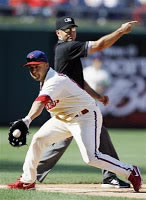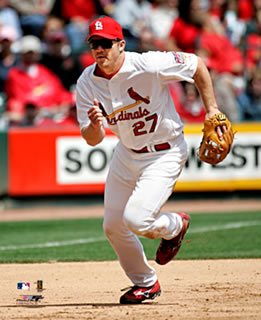| Common third base mistakes
By: Coach McCreary Provided by: Baseball by the Yard
Playing too shallow. I suppose there may be coaches or players who would disagree with this but I believe it is too common. Obviously, if a third baseman has a weaker arm it would be natural for him to play a little more shallow. However, many players have enough arm strength to play deeper but do not. A lack of range is the obvious problem with playing too shallow. Premiere third basemen are not afraid to play farther back behind the base path and cover more ground as a result. If you read yesterday’s post about shortstops, you learned about the importance of varying your positioning. This certainly applies to third as well, maybe even more so because of the need to occasionally field bunts. Look again at this visual and note how much the third basemen adjust their positioning during the game. Also take note of how deep the third basemen play most of the time. One result of playing deeper is the need to charge more aggressively on slower hit balls. Keep reading below for more information about that.
Not knowing the pitch. Third base is called the “hot corner” for good reason. Bullets hit down that way are the norm for third basemen and require quick feet and fast reactions (More reason to play deeper!). Knowing what pitch the pitcher is throwing can give the third baseman a “heads up” as to when batted balls may be more likely to come his way. Unfortunately for third basemen, catchers are taught to hide their pitch signals from everyone except the pitcher and the middle infielders. The downside of this is that the third baseman cannot see the signs. Let’s say a hard thrower is on the mound. It makes sense that right handed batters would be much more likely to pull a ball down to third base if that pitcher throws a change-up as opposed to a fastball. If I play third, I want to know when that pitcher is throwing a change-up. But how do I know if I can’t see the signs? The answer is the shortstop tells you. When the catcher gives the sign, some shortstops will give some kind of verbal cue to the third baseman to alert him of a particular pitch. He might say the pitcher’s number or first name when an off-speed pitch is coming and may say another word or nothing on a fastball. There are many options that can be worked out beforehand. (Note: this can be done by the 1st and 2nd basemen as well). This tip might give a third baseman an extra step and/or a better sense of readiness. Be careful and discreet though. The other team might catch on to what you’re saying.
Too slow on choppers and slow rollers. These are probably the toughest plays a third baseman has to make. He has to read the speed and hops of the ball as well as the hitter’s running speed and determine whether to charge hard or wait back a little more for a good hop. That being said, I believe too many third basemen error too much on the side of caution and do not aggressively attack light choppers and slow rollers. Most of the time, if the third baseman hesitates or comes up short in his attack even a little, the runner is safe. To improve, it is important that third basemen practice a few of these plays every day at game speed. The use of a stopwatch can be valuable in this process. Have a coach roll a ground ball and start the timer as soon as the ball leaves the coach’s hand. Stop the timer when the ball is caught by the first baseman. Continually try to cut the time it takes to make the play. Remember, an average major leaguer gets from home plate to first base in just over 4 seconds. If you want to continue playing third as you get older, these are plays you have to routinely make under that time. Unaware of who is pitching. This applies to the cooperation between the pitcher and third baseman on bunt plays with a runner on second base. One of the more challenging responsibilities for a third baseman is reading the ball off the bat on a bunt and determining whether to charge and make the play or stay back at the bag and let the pitcher get it. Knowing how good your pitcher is at getting off the mound on bunts is essential. Different pitchers have different levels of foot speed and quickness. Some hop on bunts like a cat. Others seem to take forever to get off the mound. Either way, the third baseman needs to know who is on the mound and how good they are at getting to bunts. Paying close attention to how well pitchers do this in practice is important. This can impact where the third baseman starts on the play. If the pitcher is quick, the third baseman might play a step deeper. If the pitcher is slow-footed or maybe falls towards the first base side after each pitch, he may have to play in on the grass a bit more. The point is, know who is pitching.
|









